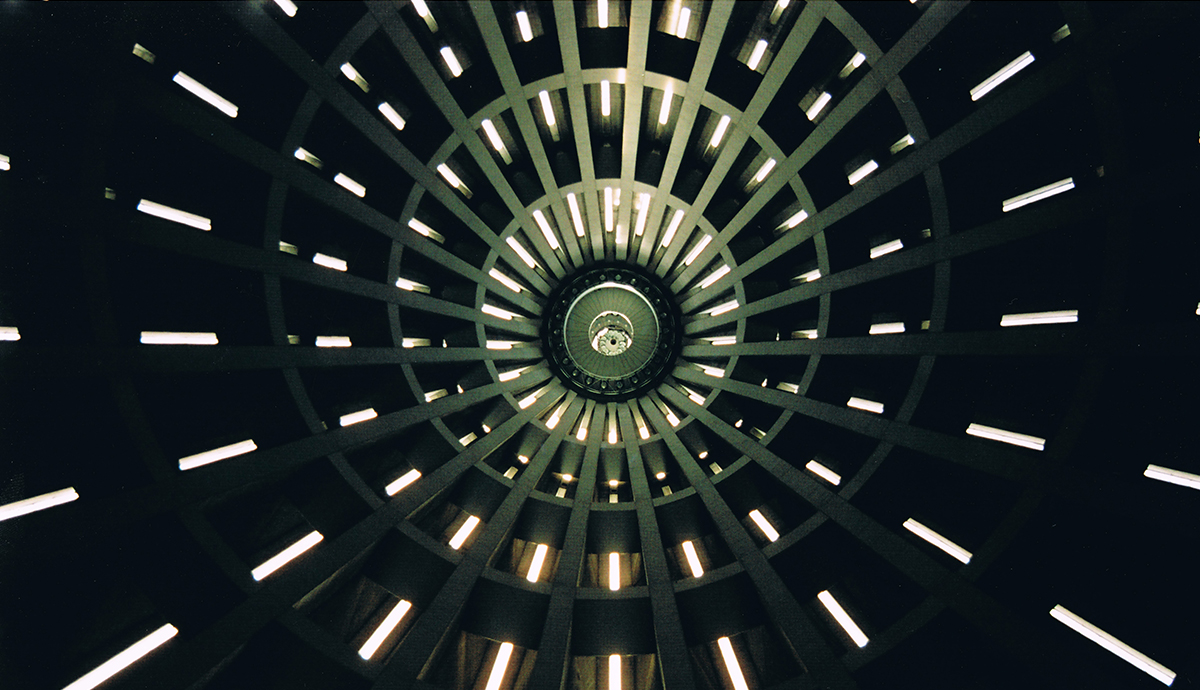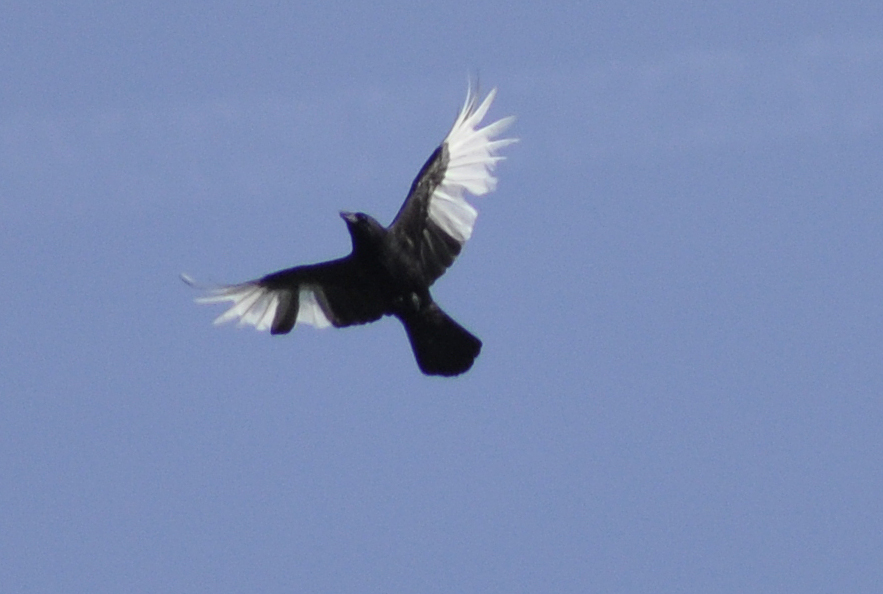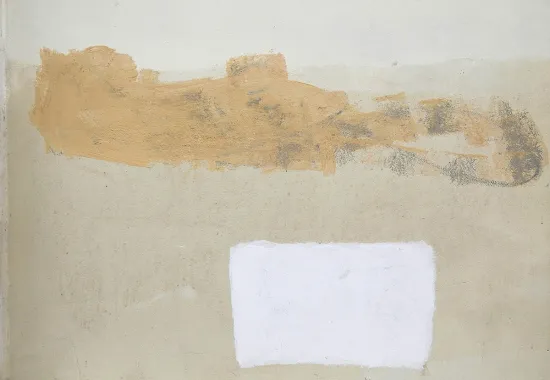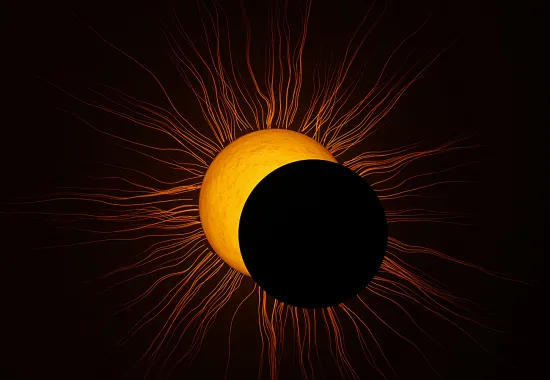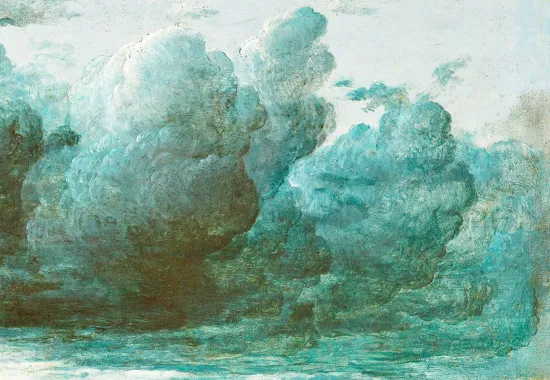Pile, Grace
Drivers in San Diego love to gripe about congested freeways, how LA-style gridlock has crept south through Orange County to slow commutes straggling through the tawny, militarized foothills of Camp Pendleton south to the smoke-clogged morass of the U.S./Mexico border. My car was idling along the stilled 805 exchange on an arid September evening with the windows down, several lanes over from the thatchy chaparral, yellow wildflowers and short, twisted pines rimming the freeway embankments.
From across the center divider, I watched a black crow take off, flying low over multiple lanes of stopped cars. With my window rolled down, I could see that the crow held a small slip of paper in its beak, perfectly rectangular and about the length of three postage stamps. As it crested the center divider, for whatever reason, the bird released the paper scrap and continued stroking evenly, disappearing somewhere into the hard, shining traffic. I looked at the paper scrap, abundantly visible on the rough pavement in the lane next to me. And I thought about getting out of my car to retrieve it.
As writers we pile up and strip down, making things bigger in order to make them smaller, better. The word poetry comes from the Latin poietes, itself a descendent of an Indo-European ancestral language dating back over 5,500 years, incorporating the Sanskrit word cinoti, which means “heaping up, piling up” and also the Old Church Slavonic word činu, meaning “act, deed, order.”
As a yoga teacher, I know that we get stronger from the inside out, creating denser bones and more capable muscles through repetition, impact, and tiny fiber tears—a subtle cycle of injury and repair. But we get closer to our strength from the outside in, burning through fat stores to tug our skin closer to the bone. The skin, indeed the body, is a beautiful sack for muscle, organ, fat and bone.
How slowly and similarly do we make art—repetition, impact, infinitesimal rips; an intentional imperfection that gets bigger before it gets smaller, more reflective and honoring of the bone. Composting and fossilizing are both, I think, familiar and apt metaphors for this telescoping process that is art making; we pile up and we burn through.
When I taught middle school science, students sometimes struggled with the word humus, its odd relations with human, must, musk mucus, and the beany humbleness of hummus. Humus forms when leaves, twigs and animal remains decompose, collapsing together into a dark, organic mixture that earthworms root through, eat and expel, making an even earthier blend.
How interesting to be an earthworm myself, rooting through the human basement of my life, digesting little teaspoons of rocks and decay. When I wrote “A Personal History of Dirt,” I wasn’t thinking about earthworms and humus. Sometimes the back-story comes later; an elaborate, linear and maybe pointless psychologizing of how, where and why something becomes something else.
But consciously piling up is a metaphor for unconscious piling up, which, wonderfully, I can’t predict or control. I can engage in physical collecting to remind myself that I am collecting things I can’t see until they scratch at the surface in a poem or essay. I save little ribbons, paper scraps and twigs for a nest that may never become.
Visiting a James Turrell light exhibit in September at the Los Angeles County Museum of Art, I note this statement by Count Giuseppe Panza di Biumo: “A huge city like Los Angeles is a minor event…but even if our life is not lasting we can know things.” There are notes from a yoga class I took late at night in November: “What will you give up? What are you willing to give up? Trust that your body feels itself.” Did my yoga teacher say that? Was that me?
And maybe I get it wrong. For example, at a SDSU reading in November, did Tomaž Šalamun say “Are you a prisoner on purpose?” or did I think he said it? C.D. Wright might have said, “Look at your heart and see what the dark eats other than the dark,” while reading at a Red Hen Press event, but probably I misheard her over the clink of water glasses and whispered requests to pass the salad dressing. Maybe it’s what I wished she was saying. I could look it up, sure. But maybe the mistake is part of the feeling.
And what about this: “Not everything needs to be measured.” Where did that come from? “Marquee romance as punishment.”
“Every kick a different death.” Pile, pile. I write these down so that I can look away from something that is not being written down.
Every line is a wish for the unknowable line.
A talented landscape painter I once interviewed for a surf magazine refused to say how long it took him to create a single painting. “Write down that it took my whole life,” he instructed. “Because it did.” How that is true and also not true.
And so it goes, the nests and hives and window frames. Things to crawl into or look out from. As a newspaper reporter I once wrote about a sewage treatment plant that could convert vats of hot, muddy sludge into dry, crumbly, pathogen-free fertilizer that you could safely plunge your hands into, if you wanted. How? Repetition, heat, pressure, basically, changing shit to dirt and sold in $8 sacks.
And this scrap reminding me how, in high school, I bought a tissue-soft, maroon-colored T-shirt from a thrift store that was printed with the logo, “Sewage Treatment Plant Inspector” to wear with cut-off shorts. At breakfast, my mother saying sadly, “When you were a baby I would debate for hours. Do I put her in her little pink pajamas? Or her little yellow pajamas? And now that baby is wearing a shirt with the word sewage on the front.”
And how maybe I thought I was saving that moment for a poem. How I’m now remembering the seams of dirt tracking my father’s hands after a long day at the plumbing shop, how he would scrub his hands with the hottest water and Dove soap before sitting down to dinner for grace. How I used to be a person who said grace.
And how there is no saving, really. Crows eat songbirds. The beak opens. Things drop.
The mind is a nest we build, hoping something can live there. I know that the nest I’m building is not the nest I’m really building.
The crow, the paper scrap. It doesn’t matter what it said.
Emily Vizzo is a San Diego writer and educator who recently completed her MFA in Writing at the Vermont College of Fine Arts. A National Writing Project fellow with the San Diego Area Writing Project, Emily currently teaches yoga at the University of San Diego. She completed her first poetry manuscript at the Vermont Studio Center in August, and her North American Review essay, “A Personal History of Dirt,” was recently recognized as a notable essay for Best American Essays 2013. Emily's poem, "A Personal History of Dirt," is featured in issue 297.3.
Recommended
Mercy
Eclipsing
Psychic Numbing


